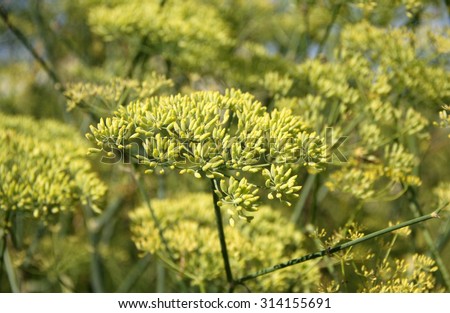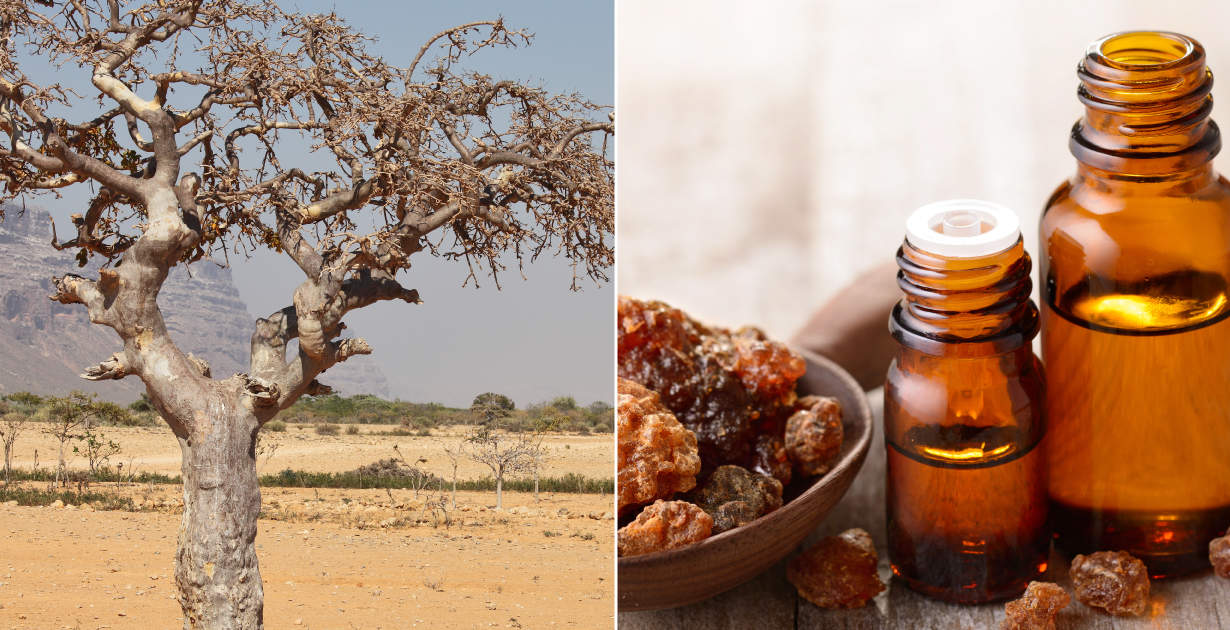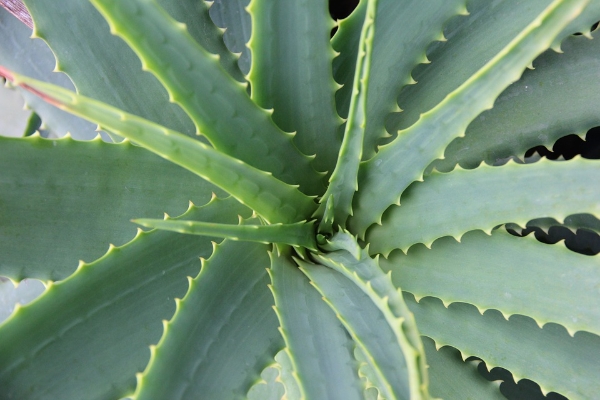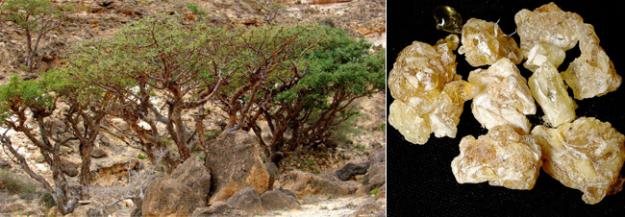All your robes are fragrant with myrrh and aloes and cassia; from palaces adorned with ivory the music of the strings makes you glad. ~ Psalm 45:8
Have you ever considered where your favorite scented bath oils and room fragrances originated? Or, like me, did you just take for granted these luxurious little pleasures?
Just as the culinary and medicinal herbs I’ve talked about in recent posts began in ancient history, so did all the natural elements that go into creating and blending various fragrances and ointments to soothe aching muscles and tired bodies. Here’s a primer of spices found in the biblical literature.
Myrrh (Commipora myrrha) is an oil extracted from the gum resin of the myrrh tree, pictured below. The pale yellow liquid turns dark as it solidifies.
Aloes (Aloe succatrina Lam), a member of the lily family, bears clusters of thick basal leaves. Numbers 24:6 describes God’s dwelling places “like gardens beside a river, like aloes planted by the Lord . . .” The ancients dissolved aloes in water and mixed it with myrrh for use in the embalming arts. Aloe and myrrh, for example, were used to embalm the crucified body of Jesus before it was wrapped in linen; according to John 19:39, “Nicodemus, who had first come to Him by night, also came, bringing a mixture of myrrh and aloes, about a hundred pounds weight.”
Cassia (Cinnamomum cassia Blume), as its Latin indicates, resembles the Ceylon cinnamon tree (cinnamomum zeylanicum). However, the cassia bark is less delicate and sweet. Sometimes called a “Chinese cassia,” the tree is an evergreen that originated in Burma and China but is cultivated also in southern and eastern Asia. It’s the aromatic bark that’s used as a fragrance and a spice, although the whole tree — flowers, fruits, leaves, roots — exudes a spicy aroma.
All three of these spices were combined with others in a base of olive oil to create the “oil of gladness” for anointing. Certain priests in Temple times specialized in following the formulas for making the oils, as well as incense, used in worship.
The wealthy used fragrant powders for scenting their houses, garments, beds, and bodies. “I have sprinkled my bed with myrrh, aloes and cinnamon. Come, let us drink our fill of love until morning; Let us delight ourselves with caresses,” Solomon wrote in Proverbs 7:17-18. The Song of Solomon describes the marriage procession as “perfumed with myrrh and incense made from all the spices of the merchant” (Song of Songs 3:6) and compares the features of Solomon’s bride to “an orchard of pomegranates with choice fruits, with henna and nard, nard and saffron, calamus and cinnamon, with every kind of incense tree, with myrrh and aloes and all the finest spices.”
Nard or Spikenard (Nardostachys jatamansi) is a fragrant amber colored ointment made from dried roots and wooly stems of the spikenard plant–a flowering plant of the Valerian family–that is native to the Himalyan mountains of China, Nepal, and India. The Chinese refer to spikenard as Gan Song, translated to “Sweet Pine,” a good indicator of its scent. The precious ointment was and still is imported from northern India and, therefore, quite expensive. As in Bible times, nard still is stored in alabaster jars to preserve its fragrance.
Mary of Bethany, the sister of Martha and Lazarus, poured out very expensive “perfumed oil, pure nard,” on Jesus’ hair and feet. The small jar of “genuine nard” filled the house with the fragrance, according to John 12:1-3.
Frankincense (Boswellia rhurifera Roxb) tree is native in India and Arabia. In ancient times, 2500 years before Christ, the Egyptians used frankincense for mummification of pharaohs as well as in their religious rituals. We are perhaps most familiar with the word from the Christmas/Epiphany story of the astronomers, or Magi from Persia and Arabia, bearing gifts of gold, frankincense, and myrrh (Matthew 2:1-2, 11). Frankincense is a component of holy incense (Exodus 30) derived from smoking the small yellow beads of hardened clear yellow resin of the tree.
HERBS OF THE BIBLE
Almost every conceivable herb we grow in our own gardens today were available in ancient times, cultivated in the hot climate of the Mediterranean and the Middle East. They were grown for both culinary and medicinal use. Since I’ve written in previous blog posts about these herbs, I’ll only describe those I’ve not mentioned; namely, Anise, the six Bitter Herbs, and Wormwood.
Anise (Anethum Graveolens L.) grows like dill, fennel and parsley. Only Matthew 23:23 mentions anise.

Bitter Herbs were gathered fresh and eaten as a salad at the Passover, according to Exodus 12:8 and Number 9:11. These are Common Chicory, Dandelion, Endive, Garden Lettuce, Sorrel, and Water Cress, all of which are familiar greens today. (Note: I do NOT eat dandelions!)
Wormwood (Artemisia judaica L.) or Mugwort (Artemisia vulgaris) is related to the American western sagebrush. Its dried leaves yield the liqueur Absinthe. The word “wormwood” is translated from the Hebrew la’ana, meaning “curse” or bitterness. Jeremiah 23:15 and Lamentations 3:15 and 19 refer to “. . . the bitterness and the gall.” Artemisia vulgaris is a known biblical metaphor for unpalatably bitter things or events. Interesting enough, the Ukrainian word is чорнобиль or “Chornobyl” which we recognize as the town of Chernobyl.
The word wormwood appears in Revelation 8:10-11 and used as a metaphor for calamity and sorrow. “The third angel sounded his trumpet and a great star, blazing like a torch, fell from the sky on a third of the rivers and on the springs of water — the name of the star is Wormwood. A third of the waters turned bitter, and many people died from the waters that had become bitter.”
All symbolism aside, wormwood really is an herb. The above-ground plant parts and oil were used for various digestion problems such as loss of appetite, upset stomach, gall bladder disease, and intestinal spasms. Moreover, a couple of alcoholic beverages are made with extract of wormwood, such as Vermouth. Absinthe, distilled in the late 18th century, is an emerald-green spirit — not a liqueur — prepared from the oil of wormwood, along with dried herbs such as anise and fennel. Its herbal complexity makes it taste somewhat like licorice candy with an alcohol content up to 70 percent by volume! By the way, the sale of absinthe is illegal in the United States, so don’t both looking for it.
Which are your favorite herbs and spices, whether for culinary or medicinal purposes? Mine is anything lavender. Send me a comment or email me at pineoakes@gmail.com and start a conversation.











2 thoughts on “Herbs and Spices in the Bible”